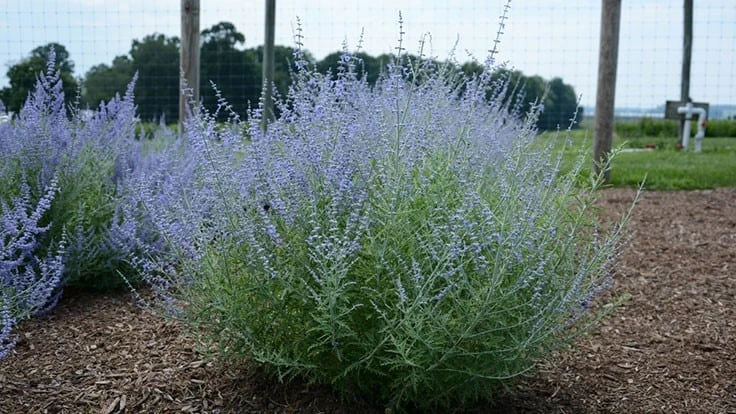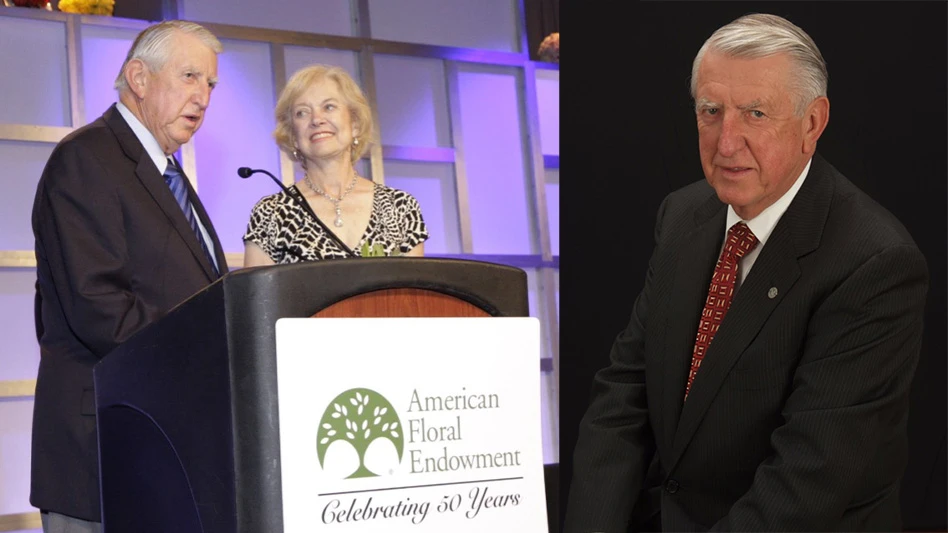
Ball Horticultural Company

Russian sage is a popular garden and landscape plant valued for its lavender-blue flowers over a generous bloom period, silvery green leaves, shrubby habit, and companionability with many other plants. Long cultivated as an herbaceous perennial—it was introduced into the United Kingdom in the early twentieth century—Russian sage is technically a subshrub, which is a plant with a woody base that produces herbaceous stems during the growing season. Incidentally, in spite of its common name, Russian sage is not native to Russia.
Perovskia spp. is a member of the mint family (Lamiaceae) with seven species native to southwestern and central Asia.
A number of cultivars attributed to Russian sage (P. atriplicifolia) are widely cultivated; another species, Caspian sage (P. abrotanoides) is less common in gardens. However, botanical traits of P. abrotanoides—most notably bipinnately dissected leaves and narrow flower panicles—are present in some cultivars of P. atriplicifolia, leading to the presumption that these cultivars may be hybrids between the two species. Recent taxonomic developments subsumed Perovskia into the genus Salvia, and P. atriplicifolia specifically, has been renamed Salvia yangii.
Shades of lavender-blue prevail, with slight differences in flower and calyx colors noted among the cultivars. The small bilabiate flowers—typically half an inch long and one-quarter inch wide—feature broad, four-lobed upper lips and narrow lower lips.
Flowers open randomly and sporadically from early July into October in Chicago, and although bountiful over the entire season, they are not open in great enough quantities at any time to be truly impactful on their own. Instead, the fuzzy purple calyces that nestle the flowers command the floral display; calyces are colorful before flowers open and persist long after the flowers have dropped. By late summer to early autumn, the fading calyces begin abscising and the ghostly skeletons that remain, together with the silvery stems, provide some ornamental appeal in the winter months.
The foliage of Perovskia atriplicifolia and P. abrotanoides are distinct from each other. The ovate-oblong leaves of P. atriplicifolia are entire or sparsely to bluntly toothed, whereas the ovate leaves of P. abrotanoides are bipinnatifid, or twice pinnately cleft.
The hybrid origin of commercially available Russian sages in the United States is suggested by the foliar traits of the cultivars, which vary from ovate to lanceolate with entire, serrate, or deeply incised margins.
The silvery to gray-green leaves range from 1 to 2 inches long and are pungently aromatic when crushed. Like the inflorescences, the square stems are covered in grayish white hairs. Plant sizes and habits vary among the cultivars. Older cultivars such as ‘Filigran’ and ‘Superba’ tend to be large—4 feet or taller—loose in habit and may develop lax to floppy stems even in full sun. Newer cultivars such as ‘Blue Jean Baby’ and ‘Rocketman’ have sturdy, compact habits, and are typically less than 3 feet tall.
Trial results

The Russian sages were regularly observed for their cultural adaptability to the soil and environmental conditions of the full-sun evaluation garden; diseases and pests; winter hardiness and survivability; and ornamental qualities associated with leaves, flowers, and plant habits. The final performance ratings, which are based on foliage and habit quality, flower production and floral display, plant health and vigor, and winter hardiness. Five cultivars earned five-star excellent ratings for their superior floral displays and consistently strong habits: Blue Spritzer, ‘Blue Jean Baby’, ‘Blue Steel’, Little Lace, and ‘Denim ‘n Lace’.
The Chicago Botanic Garden (USDA Hardiness Zone 5b, AHS Plant Heat-Zone 5) completed an eight-year comparative trial of Russian sages in October 2020. A goal of the trial—beyond observing overall garden performance and distinguishing the ornamental traits of commercially available Perovskia—was to consider the possible hybrid status of each cultivar based on floral and foliar morphology. Fourteen taxa were evaluated for a minimum of four years between 2013 and 2020; not all taxa had been introduced at the outset of the trial in spring 2013. ‘Blue Jean Baby’, Blue Spritzer, ‘Denim ’n Lace’, and ‘Rocketman’ entered the trial in the spring of 2015. Sources for a few commonly referenced cultivars such as ‘Blue Spire’ and ‘Blue Haze’ could not be found so were not included in the trial. Perovskia atriplicifolia ‘Little Spire’ was confirmed incorrect in 2015 and removed from the trial but not replaced.
Despite the recent nomenclatural reassignment of Perovskia to Salvia, plant names cited here remain unchanged due to their widespread usage by gardeners and the green industry. Three plants of each taxon were grown in side-by-side plots for easy comparison of ornamental traits and landscape performance.
The full-sun evaluation garden received up to 10 hours of sunlight daily during the growing season and was openly exposed to wind in all directions. The clayloam soil had a pH of 7.4 during the trial period, and although typically well-drained, the site occasionally retained excess moisture for short periods in all seasons. Trial beds were irrigated via overhead sprinklers as needed, mulched with composted leaves once each summer, and regularly weeded. Plants were not deadheaded, fertilized, winter mulched, or chemically treated for insects or diseases. Plants were cut back to approximately 6 inches in spring before new growth began.
The lavender-blue flowers and purple calyces of Perovskia atriplicifolia ‘Balperobritz’ Blue Spritzer were noticeably lighter in color than other selections and loosely gathered in airy spires. Flower production decreased gradually over the bloom season, but the purple calyces extended the color show into early October. Blue Spritzer featured egg-shaped, silvery green leaves with entire margins, although some leaves were occasionally serrated. The bushy, vase-shaped habit—30 inches tall and 36 inches wide—and the prolific floral display were reliable every year.
Perovskia atriplicifolia ‘Blue Jean Baby’ is a compact selection just under 30 inches tall and 32 inches wide. The full, bushy plants were consistently uniform in size and shape, which was a trait not always evident on other cultivars. From early July to October, a profusion of lavender-blue and purple flowers were densely borne in compact panicles. The inflorescences began thinning in early August as spent calyces abscised; typically, up to 50 percent of calyces held a vibrant color into early October, although no flowers were present by then. The deeply dissected sage green leaves had a soft textural quality compared to the entire leaves of Blue Spritzer.
Perovskia atriplicifolia ‘Blue Steel’, a seed cultivar that displayed uniform bushy habits and heavy flower production, compared favorably to vegetative cultivars. The dark lavender-blue flowers, nestled in purple calyces, were borne in airy panicles from mid-July to October. The retention of the calyces varied from year to year, ranging from 30-90% holding and colorful in early October. The ovate, green leaves had bluntly serrated, wavy margins and were citrus-scented. Plants were 32 inches tall and 34 inches wide with a comparable but tighter habit than Blue Spritzer.
Little Lace (Perovskia atriplicifolia ‘Novaperlac’) provided an impressive flower show from early July into October. The medium lavender-blue flowers with purple calyces were loosely clustered in terminal panicles on sturdy stems. Thinning of the inflorescences began in early August, although up to 30 percent of the calyces remained colorful into early October. The compact bushy plants—32 inches tall and 38 inches wide—had a fine-textured appearance due to the deeply incised gray-green leaves and the airy inflorescences.

While not fully comparable, Little Lace resembled a shorter, more refined version of ‘Filigran’. The lavender-blue and purple flowers of Perovskia ‘Denim ’n Lace’ were densely clustered in upright panicles, giving the inflorescences a more substantial appearance.
A profusion of blooms topped upright, sturdy stems from mid-July to mid-October. Bees and other insects were constant visitors during the long bloom period. The Russian sages generally remained healthy and thrived in the trial site.
Plants were typically killed to within several inches of the ground every winter during the 2013-2020 trial period regardless of snow cover; however, plants of ‘CrazyBlue’, ‘Filigran’, and ‘Superba’ were regularly killed to the snowline only, which varied in height based on annual snowfall. Unexpectedly, all plants were alive below the snowline—a depth of approximately 8 inches—during the winter of 2018-2019, which recorded a nearly record low of -23°F on Jan. 30, 2019. In some years, a small portion of stems did not resprout in the spring after being cut back. Left in place, the bare stubs looked untidy and detracted from habit quality, most noticeably in the spring and early summer. There were no diseases or pests observed during the trial period; foliar chlorosis was a minor issue observed on all taxa in most years.
New introductions of Russian sages in recent years have expanded offerings beyond traditional cultivars such as ‘Longin’, ‘Filigran’, and ‘Superba’. Plant size is the main distinction between new and old cultivars; most new introductions have shorter, more compact habits. Additionally, more condensed, crowded inflorescences have amplified the color show on some new selections.

All taxa in the trial had impressive floral displays over a protracted period, but typically lost points for inferior habits. Lacey Blue was the only taxon to receive a poor overall rating, due to its persistent floppy habit. Several taxa exhibited patchy crowns of small satellite plants surrounding a declining central crown. While perhaps more tolerable in mass plantings, the loose, irregular habits would be less desirable for a specimen plant.
Prized for their fuzzy lavender-blue flowers and silvery-filigreed foliage, Russian sage remains popular because they are dependable garden plants, are suitable to a variety of landscapes, and are great companions to a myriad of perennials and grasses. The newer cultivars exemplify the positive aspects of Russian sage, while increasing their versatility in smaller spaces. Whether tall or short, Russian sages provide structure and a long season of bloom that gardeners can count on.

Explore the October 2021 Issue
Check out more from this issue and find your next story to read.
Latest from Nursery Management
- Grant awarded to test western U.S. wood species for use as wood fiber potting substrate
- Pennsylvania Horticultural Society announces 2025 Gold Medal Plant winners
- Leading Women of Horticulture: Angela Labrum, Bailey Nurseries
- The HC Companies, Classic Home & Garden merge as Growscape
- Terra Nova releases new echinacea variety, 'Fringe Festival'
- Eason Horticultural Resources will now officially be known as EHR
- BioWorks receives EPA approval for new biological insecticide for thrips, aphids, whiteflies
- Ellen Mackenbach-Lakeman appointed new CEO of Dümmen Orange





